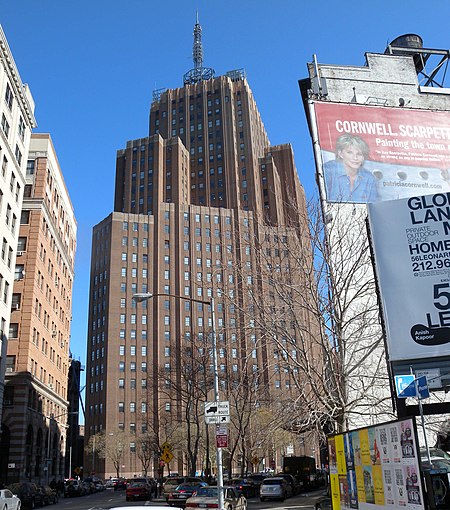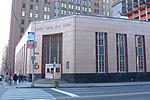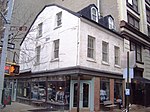32 Avenue of the Americas

32 Avenue of the Americas (also known as the AT&T Long Distance Building, AT&T Building, or 32 Sixth Avenue) is a 27-story, 549-foot-tall (167 m) telecommunications building in the Tribeca neighborhood of Manhattan in New York City. Completed in 1932, it was one of several Art Deco-style telecommunications buildings designed by Ralph Thomas Walker of Voorhees, Gmelin and Walker in the early 20th century. 32 Avenue of the Americas spans the entire block bounded by Walker Street, Lispenard Street, Church Street, and Avenue of the Americas (also known as Sixth Avenue). 32 Avenue of the Americas was the last skyscraper designed by Walker in Lower Manhattan, as well as one of the largest telecommunications buildings from that architect. Its construction was undertaken in three stages. The first, known as the Walker–Lispenard Building or 24 Walker Street, was designed in 1911–1914 by Cyrus L. W. Eidlitz and McKenzie, Voorhees & Gmelin. In the late 1910s, 24 Walker Street was expanded by seven stories. The current skyscraper is the result of the final building campaign, which took place between 1929 and 1932. Upon completion, 32 Avenue of the Americas was the largest building in the world that specifically handled long-distance calling. The building remains in use as a data/communications center, but is no longer owned by AT&T. 32 Avenue of the Americas's design features a complex massing and numerous setbacks. The brick facade is composed of numerous hues and is topped by parapets at the roof. The other ornamental elements give 32 Avenue of the Americas the impression of being both progressive and technologically up-to-date, reflecting its interior use. Inside, the main lobby contains numerous murals that reflect the building's use as a communications hub. The exterior and lobby were designated as official New York City landmarks in 1991.
Excerpt from the Wikipedia article 32 Avenue of the Americas (License: CC BY-SA 3.0, Authors, Images).32 Avenue of the Americas
Church Street, New York Manhattan
Geographical coordinates (GPS) Address External links Nearby Places Show on map
Geographical coordinates (GPS)
| Latitude | Longitude |
|---|---|
| N 40.72 ° | E -74.004722222222 ° |
Address
32 Avenue of the Americas
Church Street
10013 New York, Manhattan
New York, United States
Open on Google Maps



